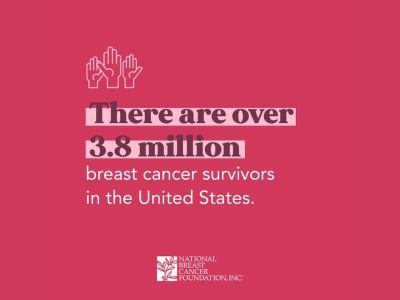Oct 13th, 2022
October is Breast Cancer Awareness Month. Let's take a closer look at the disease that 1 in 8 women in the U.S. will develop in their lifetime.
Breast cancer is a disease in which cells in the breast grow out of control. To clarify the context, it's important to know that cancer is a broad term for a class of diseases characterized by abnormal cells that grow and invade healthy cells in the body. Breast cancer starts in the cells of the breast as a group of cancer cells that can then invade surrounding tissues or spread to other areas of the body.
Although rare, men get breast cancer too. An estimated 2,710 men will be diagnosed with breast cancer in the U.S. and approximately 530 will die.
Symptoms
Most people who have breast cancer symptoms and signs will initially notice only one or two, and the presence of these symptoms and signs do not automatically mean that you have breast cancer.
- New lump in the breast or underarm
- Thickening or swelling of part of the breast
- Irritation or dimpling of breast skin
- Redness or flaky skin in the nipple area or the breast
- Pulling in of the nipple or pain in the nipple area
- Nipple discharge other than breast milk, including blood
- Any change in the size or the shape of the breast
- Pain in any area of the breast
If any abnormality if found, it's important to consult with a healthcare professional.
Risk Reduction
Although you cannot prevent cancer, some habits that can help reduce your risk are:
- Maintain a healthy weight
- Stay physically active
- Eat fruits and vegetables
- Do not smoke
- Limit alcohol consumption
If you're taking hormone replacement therapy or oral contraceptives (birth control pills), ask your doctor about the risks and find out if it is right for you. Additionally, if you have a family history of breast cancer, ask about other ways to lower your risk.
Staying healthy throughout your life will lower your risk of developing cancer, and improve your chances of surviving cancer if it occurs.
Mammograms
A mammogram is an X-ray picture of the breast. Doctors use a mammogram to look for early signs of breast cancer. Regular mammograms are the best tests doctors have to find breast cancer early, sometimes up to three years before it can be felt.
Having a mammogram can be uncomfortable for many women, even painful for some. However, the full exam takes only a few moments and the discomfort is brief. Visit How to Schedule a Mammogram for more helpful information.
Regular mammograms are the best tests doctors have to find breast cancer early.
Early Detection
Early detection includes doing monthly breast self-exams, and scheduling regular clinical breast exams and mammograms. When breast cancer is detected early, and is in the localized stage, the 5-year relative survival rate is 99% (American Cancer Institute).
“Forty percent of diagnosed breast cancers are detected by women who feel a lump, so establishing a regular breast self-exam is very important.”
-Johns Hopkins Medical
Adult women of all ages are encouraged to perform breast self-exams at least once a month.
Breast Self-Exam
Breast self-exams help you to be familiar with how your breasts look and feel so you can alert your doctor if there are any changes. Breast self-exams can be done:
- In the shower. With the pads/flats of your 3 middle fingers, check the entire breast and armpit area pressing down with light, medium, and firm pressure.
- In front of a mirror. Visually inspect your breasts with your arms at your sides. Next, raise your arms high overhead. Next, rest your palms on your hips and press firmly to flex your chest muscles.
- Lying down. Place a pillow under your right shoulder and your right arm behind your head. Using your left hand, move the pads of your fingers around your right breast gently covering the entire breast area and armpit. Repeat opposite for your left breast.
If you find a lump, schedule an appointment with your doctor, but don’t panic—8 out of 10 lumps are not cancerous.
Breast self-exams, combined with regular medical care/exams and recommended mammograms, can help find breast cancer early, when it is easier to treat.
Breast cancer is the second leading cause of cancer death in women in the U.S. Although death rates from breast cancer have been declining in recent years, the facts speak for themselves. Breast cancer is claiming the lives of hundreds of thousands of women each year around the globe.
This Breast Cancer Awareness Month, help us champion better screening and early detection, increased awareness, and continuous improvement in treatment options.
Source: Centers for Disease Control and Prevention (CDC) & National Breast Cancer Foundation, Inc.
Updated: 10/1/24

